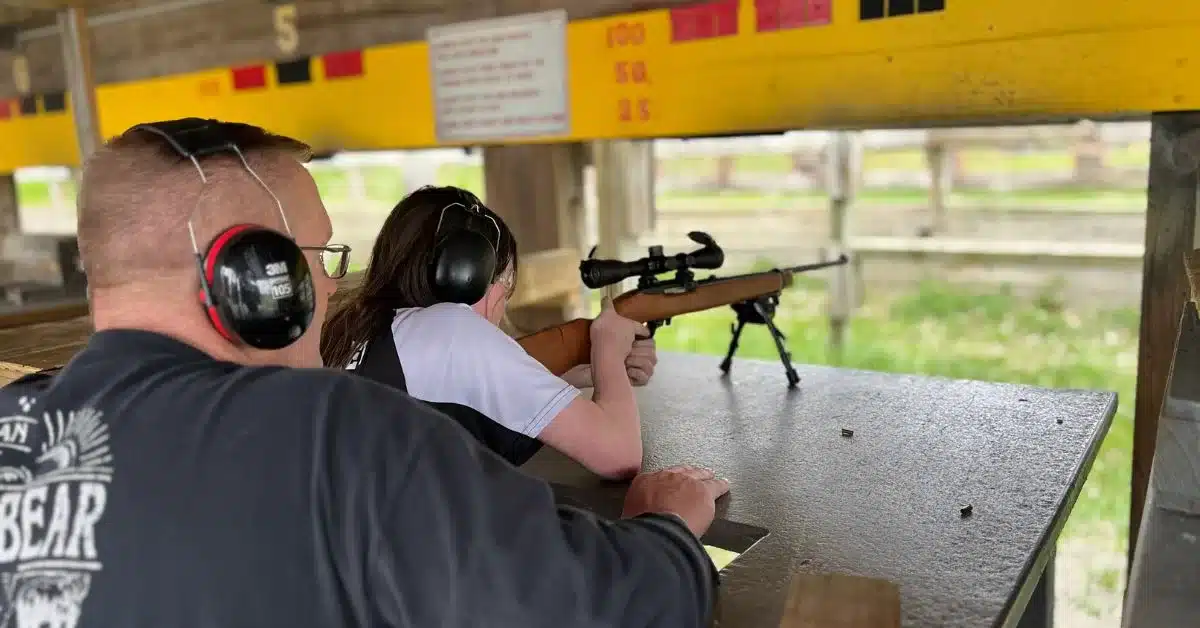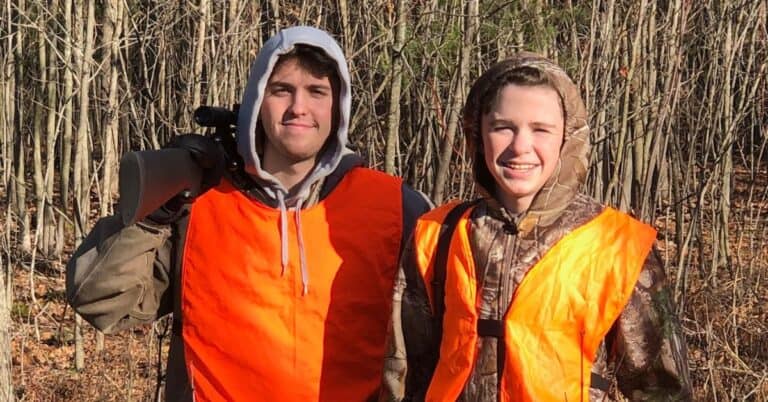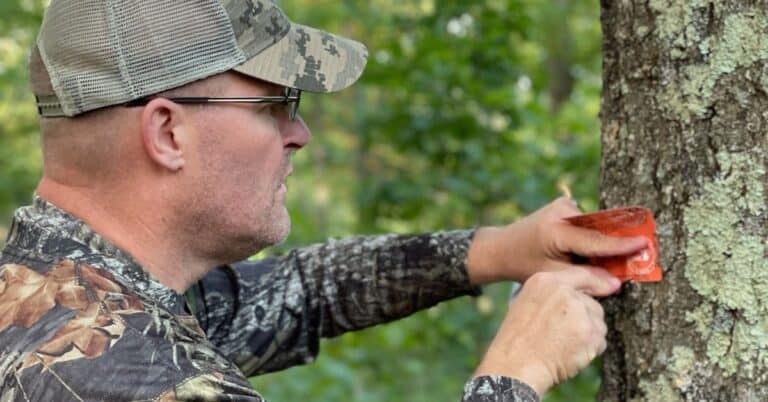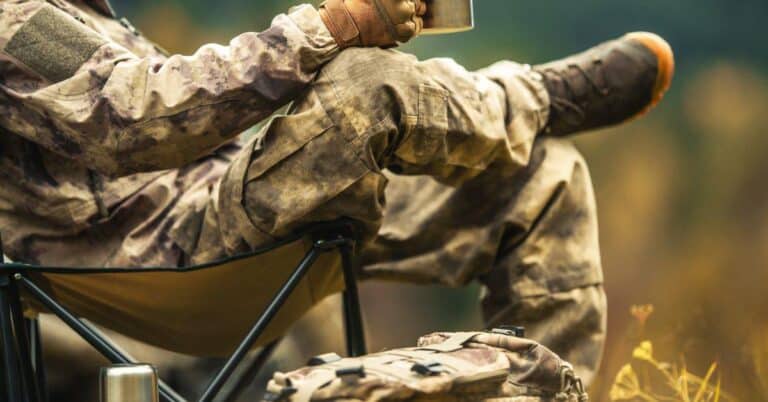Gun Range Etiquette for Beginners and New Hunters
Are you heading to a gun range for the first time and want to know what to expect? Maybe you’re worried you’ll make a mistake? Whether you’re a seasoned shooter or a beginner, the experience of hitting the range can be both exhilarating and nerve-wracking.
The purpose of our gun range visits is for myself and our boys to sight in a scope at the beginning of a season, or teach one of our sons how to shoot a different weapon. We are members at an outdoor range, the West Walker Sportsman’s Club, and typically only shoot a few rounds per visit because ammo can be expensive.
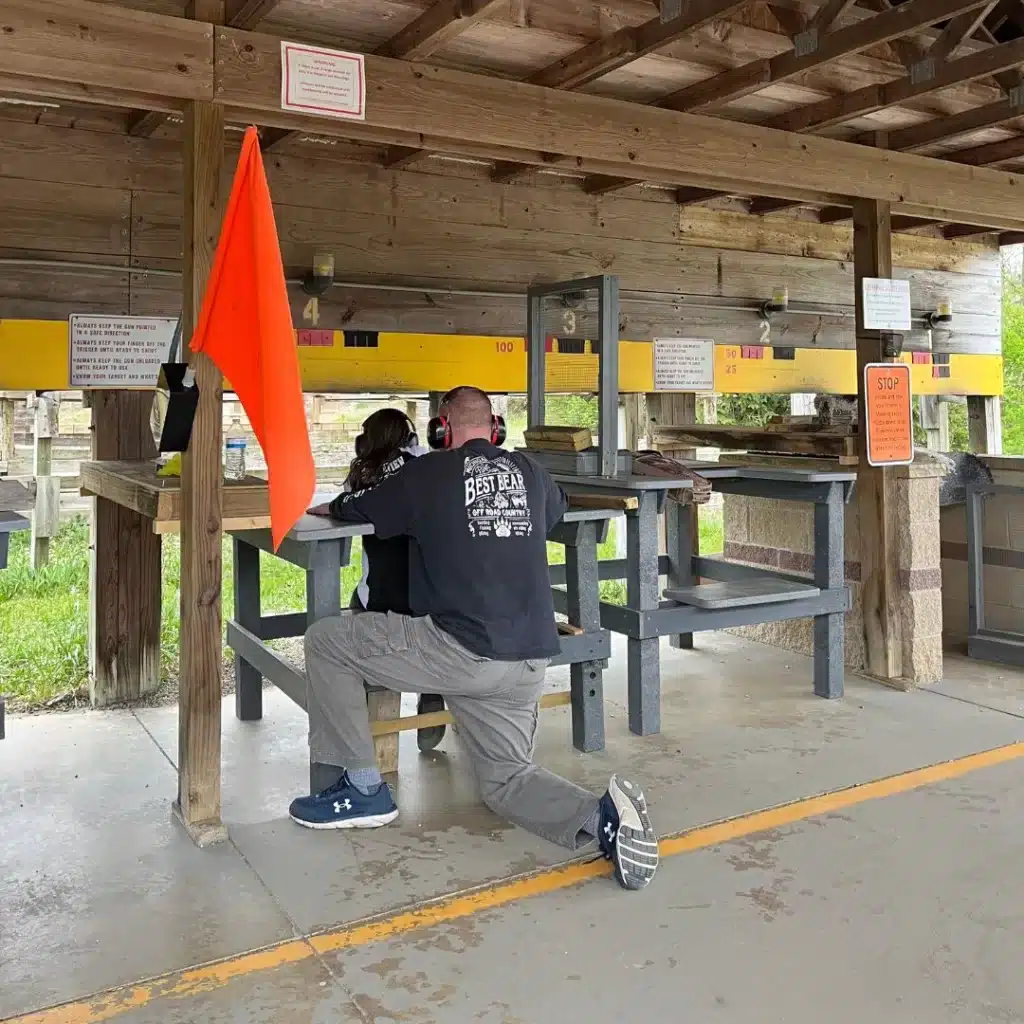
Our grand-niece went to a gun range for her first rifle shooting lesson. We aim for her to learn gun range etiquette. It marked a milestone as Bayliee had her field day the following day. Confidence in shooting was our goal, and she recently passed her online hunter’s safety course, making her journey so far enjoyable!
If you’re going to be heading to the gun range for your first time, ask questions. It shows that you want to learn and practice safe gun ownership. Some ranges offer classes and training you might want to check out. Everyone else at the gun range was new at one point, too!
Universal Gun Safety Rules
These four firearm safety rules are the most important rules for new gun owners. Get familiar with gun range etiquette and your time will be more enjoyable.
- Treat every firearm as loaded.
- Never point a gun at anything you’re not trying to shoot
- Keep your finger off the trigger until you have eyes on your target and are ready to fire.
- Confirm your target and be aware of what’s behind it.
Gun Range Rules 101
This is not an exhaustive list of rules, but a good introduction that is hopefully easy to remember. that might be easy to remember and keep in mind.
- Keep firearms pointed downrange at all times.
- Arrive with all weapons properly stored, unloaded and safely locked.
- Check in with the range officer (or range master) before unloading your car.
- Handle firearms only at your shooting station.
- Follow hot and cold range procedures.
- Obey the commands of range officers.
- Wear ear and eye protection while on the range.
- Dispose of shell casings and debris properly.
- Tell the range officer if you are new, so he can provide extra instruction.
Point the muzzle down range. All the time.
I can’t emphasize this key point enough, so I’m repeating it. New shooters break this rule often. And it will get you kicked out. Always keep the barrel of your firearm pointed downrange (towards your target).
This means when you’re shooting, when you load, when you clear a malfunction, when your finger is on the trigger, and when your finger is off the trigger. If you need to turn and talk to someone, put the gun down and point it downrange. Avoid immediate dismissal and always follow this rule.
Indoor vs. outdoor firing range
Indoor facilities often charge per hour, people try to maximize their hour, so showing up with loaded mags, a loaded firearm, and throwing up a target as soon as you get a lane is common.
One benefit of indoor ranges is a controlled climate. This is nice because you won’t have to consider the weather or adjust what you wear. Many gun owners recommend ear plugs AND earmuffs at an indoor range because they are louder.
I have done all of my practice shooting at an outdoor range. It’s where my dad got me started and it’s become my preference. I’m an outdoor kind of guy and nothing beats the fresh air and wide-open spaces. I also think they are easier on the ears and less noisy. Outdoor ranges often charge a daily fee, you can stay as long as you want.
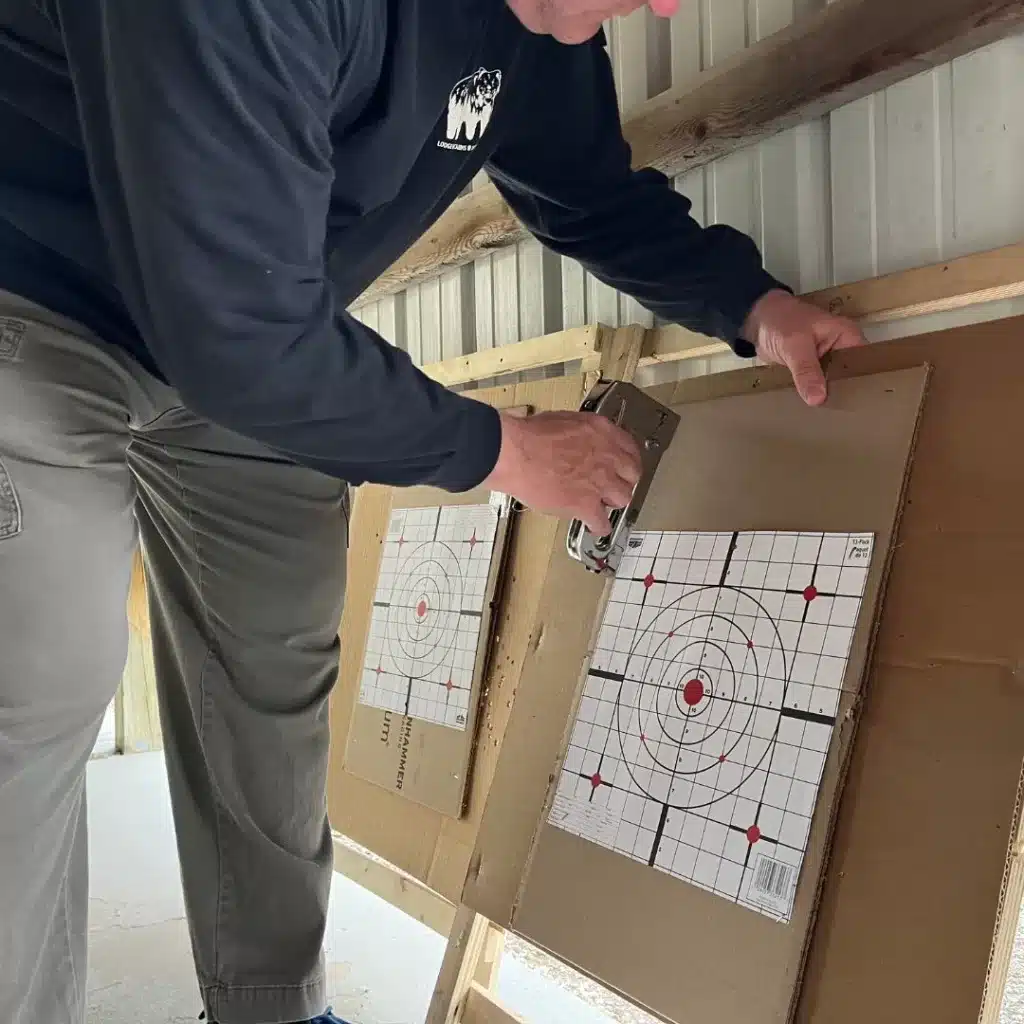
What gear do you need
- 1. Safety glasses
- 2. Ear protection
- 3. Proper storage (gun case, lock, trigger guard, etc.)
- 4. Bring your own targets
What to wear to the gun range
Ear protection is one of the most important things to remember! Severe damage to your hearing is not something to take lightly. My oldest son just passed his Concealed Pistol License and he invested in electronic ear muffs. He recommends the Walker brand, and specifically the Razor Slim Electronic Muff.
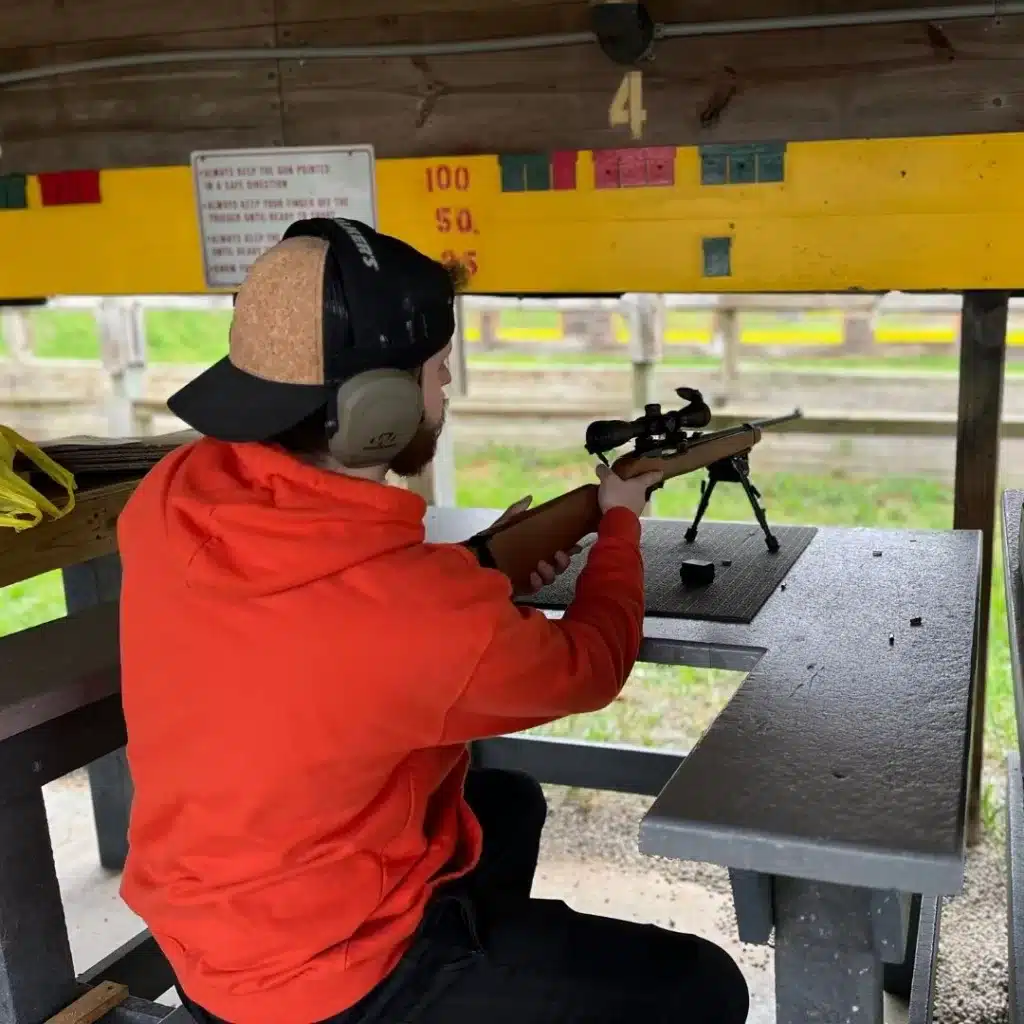
If you are going to be shooting at an indoor range, you may want to think about lead exposure. Additionally, if you are going to shoot a lot of ammo, you might want to wear a jacket or hoodie that you can take off afterwards to avoid lead dust on your car seats.
We wear whatever is comfortable, but I also like to wear orange for a little extra gun range safety. Be mindful when you get back home if you feel like you walked in a lot of lead particles. It’s best to wear closed-toe shoes. Do not wear open-toed shoes. Shorts and tank tops aren’t really a good idea either.
Reviewing safety procedures
As we drove to the range for Bayliee’s first time shooting, we reviewed a lot of rules with her in the car. Your range might be different and have slightly different rules. Our club has different ranges for pistols and long-range rifles. Be sure to check your gun range website and familiarize yourself with their rules.
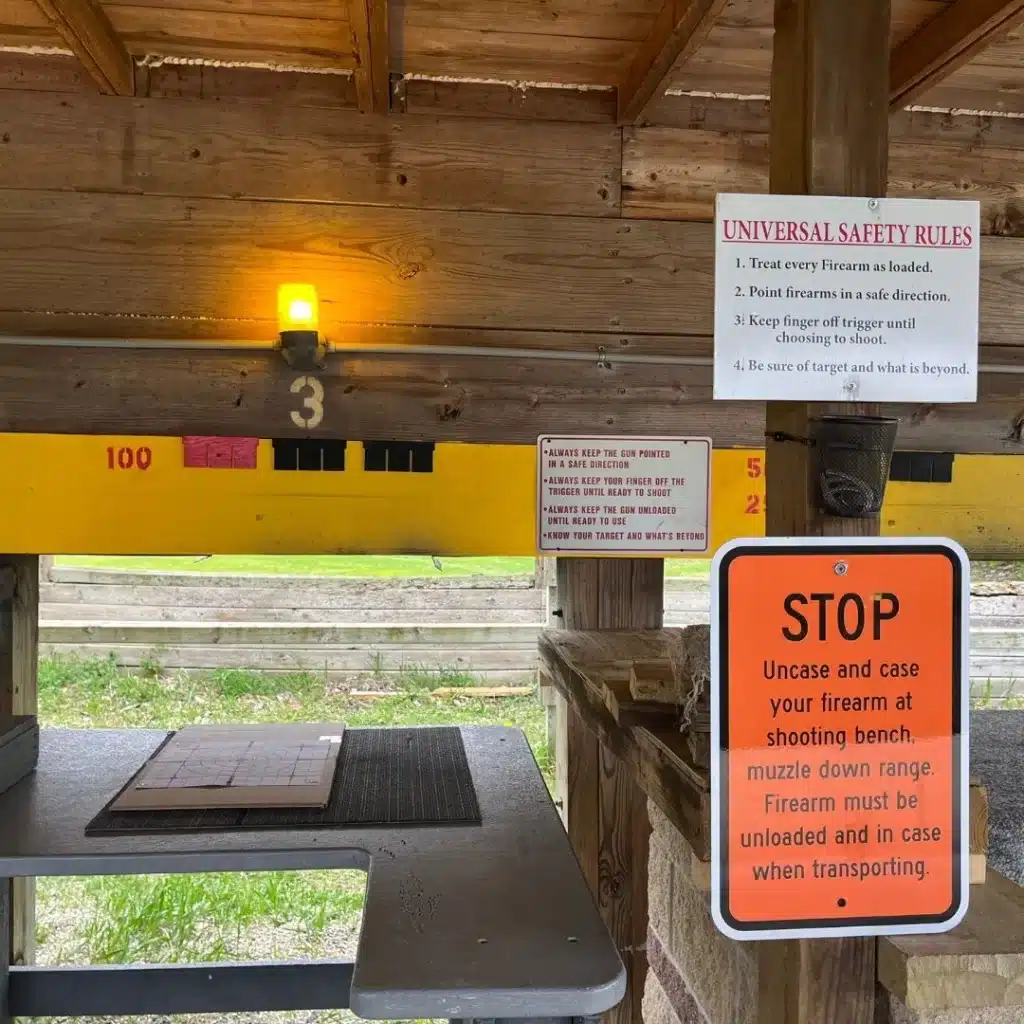
Ensure that you point your guns down range. ou may notice me repeating this point multiple times throughout the article. Then unpack (and pack up) everything in your firing line. Load your mags in the right spot. If you’re unsure about the rules at your range, ask the officer. Some ranges want you to reload at the firing line, and others may want you to go to a back table and reload there. Never take an uncased firearm to another firing line or back table.
Visually inspect each chamber and release all firing pins or hammers on empty with the gun pointing at the target.
Arriving at the gun range
I told Bayliee to wait in the car when we first arrived. Then I walked up to the small office and checked in with the range safety officer. On the check-in list I wrote my name, membership number and a “+1” for Bayliee because she’s under 18.
Unpacking your weapons at the gun range
After presenting my membership card and signing in, I walked back to the car and we started to unload. We brought one .22 long-range rifle for Bayliee’s first time. It was unloaded, with a trigger lock, and in a gun case. We carried the ammo separately.
Bayliee is hoping to hunt deer in the fall. I will gradually increase her to more power so she can shoot one of the four rifles I own for big game hunting.
Some states might require guns to be in a locked case. Ensuring firearms are in a safe condition is part of being a responsible gun owner. Read the laws in your state before owning a gun or transporting one in your car.
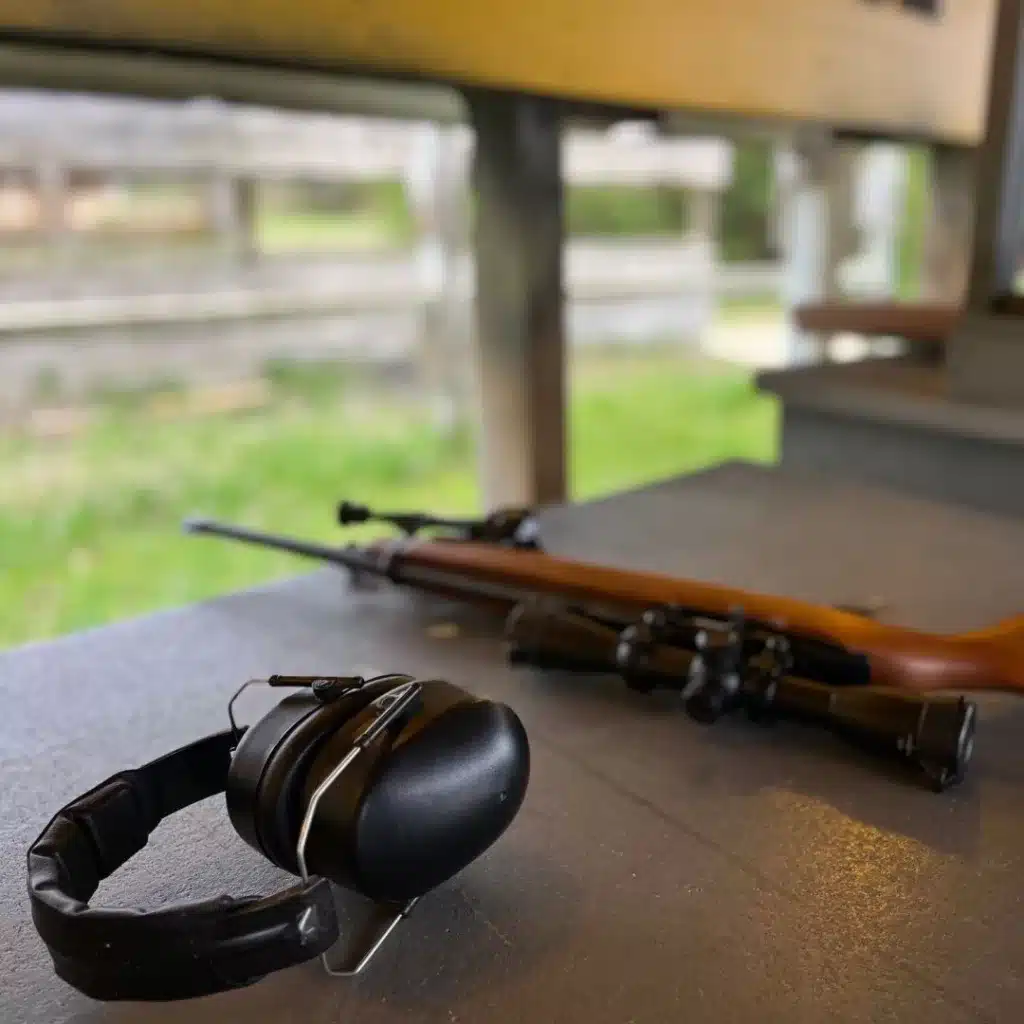
Once we entered the rifle range, eye and ear protection were required. We brought our own, but your range might provide it. You can choose ear muffs or ear plugs, whatever you prefer.
Prepare to be startled by the other gunshots during your first visit to a gun range.
There were a lot of signs on the walls to make everything clear and straightforward. Our range has a yellow painted line on the ground that you have to stand behind if you are not the live shooter. I was intentional about going very slowly and making Bayliee stay still and asking before she moved or touched anything.
What does “hot” and “cold range” mean?
Hot range is when the green light has been given for members or people using the gun range. It allows them to be at their station where they are shooting from. They can, at their own discretion, fire down range at their targets that they have set up.
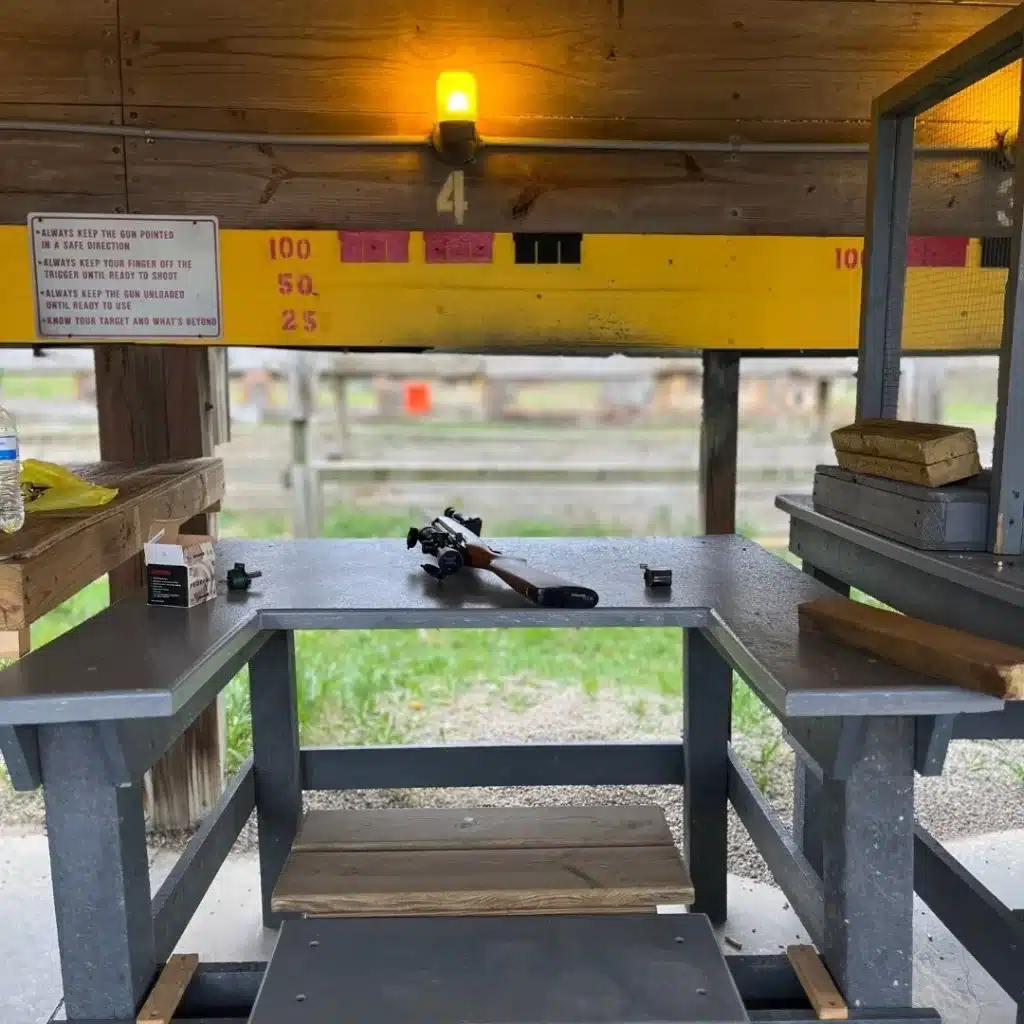
A cold range is a situation where everyone is asked to stop shooting, allowing shooters to go down range and adjust, check, or replace their targets. The term “cold range” is similar to “cease fire”. Some people could say “range is cold” or “ceasefire”, and then it’s at that point basically where you acknowledge each other on the range.
During a cold range, shooters are expected to have their firearms in a safe condition by putting them on safety, emptying the magazines, and ensuring the chamber is unloaded with the actions left open. Or simply put “Mag out, action locked back, hands off.”
Additionally, there should be no handling of weapons, not even packing or unpacking. Some ranges will want rifles on a rack, and handguns sit on the bench.
Be ready for something to go wrong
If the noise overwhelms you or if someone has a particularly loud gun, simply plan to hang out, chill, and acclimate to the noise. Be extra prepared for potential issues if you have new firearms.
You may experience a jammed casing or failure to feed. Be ready to ask for help if you’re unsure how to improve or fix the problem.
If you have not done a lot of shooting before, you may want to set your expectations to have low rounds the first few times. Some beginners get fatigued quicker that expected and your accuracy will start to decrease. Slowly build up your round count with each trip to your gun range.
Know the range’s rules
Every range is different. Get to know the rules at your range. For example, some indoor ranges have strict rules for rifles such as one round every 3-5 seconds. Rapid fire rounds will get you removed from the range.

At West Walker Sportman’s Club, there is a safety system with an orange flag and lights above each shooting stall. When the orange flag is in the stall holder, the lights are off and you are clear to fire. But if someone needs to go down range, they can grab the flag and all of the lights above the stalls in that range will light up. This signals everyone to stop shooting, set their weapons down, and step behind the yellow painted line for safety.
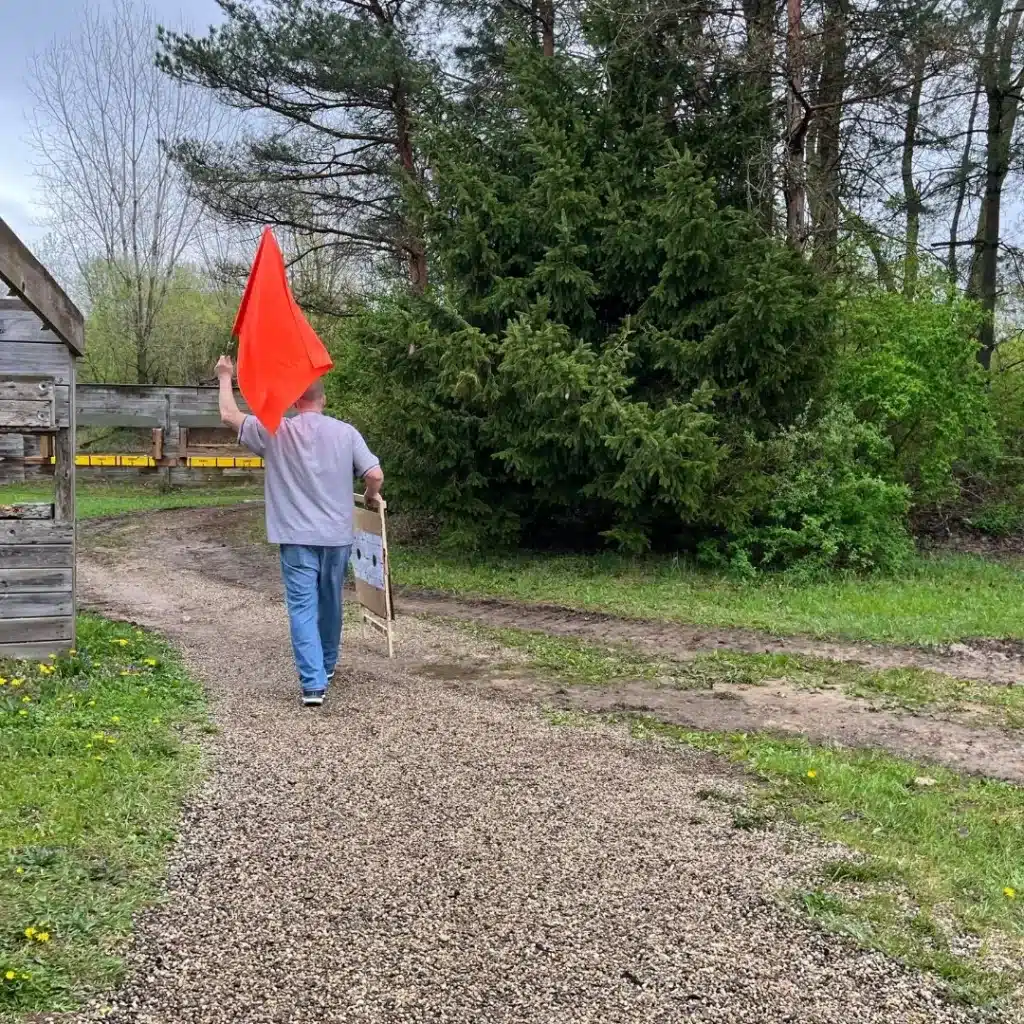
The person who wants to walk downrange and check their target then puts the orange flag in a different holder about halfway down. This flag position is visible to everyone on the range when they aim towards their target and provides an extra layer of protection.
What is a common mistake you see people make at the gun range?
Some new gun owners may just show up and not realize you have to be a member. If they’re not a member and do not know where to go, they will just walk right into the range and look for an open spot and start setting up without having the authorization to do so.
How should shooters handle their firearms when not in use?
Whether it be a soft case or hard case, you have to lay the gun in the gun case down on the table with the barrel facing down range. Then you can open it up and safely take the gun out of the case. It is typically required that guns stay in you firing lane or shooting stall. You should not move a loaded gun back and forth on a range.
What role do range officers play at the shooting range?
A range safety officer is usually on site to help direct traffic when people show up to use the gun range. They might be in a booth or a small enclosed structure where you check in. Range officers are like the referees of the range and enforce basic safety. They ensure everyone follows the rules and keep an eye out for any unsafe conduct.
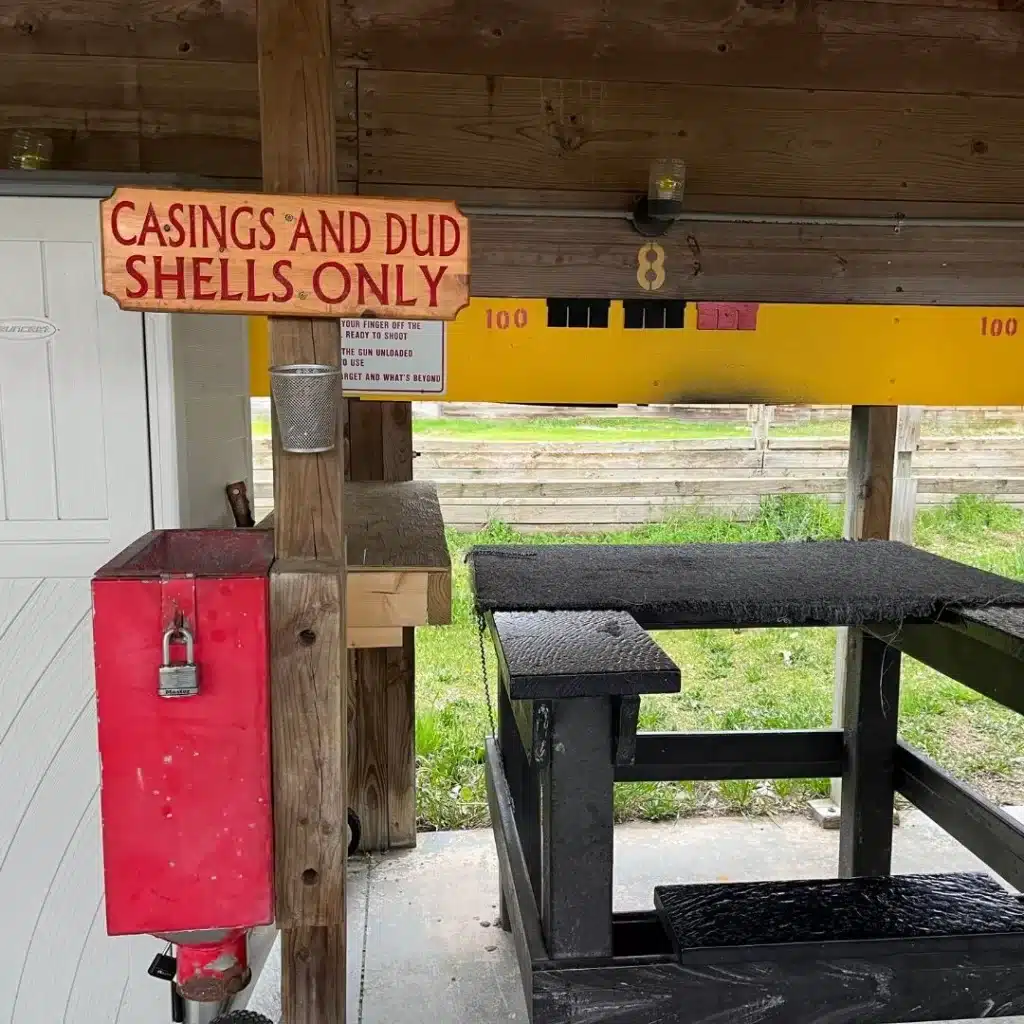
Tips for Gun Range Etiquette:
- Always check in with range staff or officers before setting up at the range to ensure you have authorization.
- Familiarize yourself with range rules and safety protocols before entering the shooting area.
- When arriving at the range, wear appropriate ear and eye protection to safeguard your senses from loud noises and debris. If your hands are going to be full when you enter, put your hearing protection on first to avoid damage.
- Follow the commands of range officers and adhere to hot and cold range procedures for safe shooting.
- Handle firearms safely by keeping them pointed in a safe direction, with actions open and unloaded when not in use.
- Choose an outdoor or indoor range based on your preference and comfort level, considering factors like climate and space.
- If you’re a new shooter, consider seeking guidance from experienced individuals or taking a tour of the range before your first session.
- When shooting, stay within your designated shooting lane or stall and be mindful of other shooters around you.
- Use proper targets and backer boards provided by the range or bring your own, ensuring they are affixed securely.
- Take down your targets when you’re done at your station.
- Dispose of shell casings (brass) and debris properly by utilizing designated collection bins or cleaning up after yourself. (Note: some ranges clean up their own brass, but this is less common)
- Do not take others’ brass without asking first.
- Respect range etiquette and fellow shooters by following safety guidelines and maintaining a safe environment for everyone.
- Prioritize safety over everything else and don’t hesitate to ask for assistance or clarification if unsure about anything.

